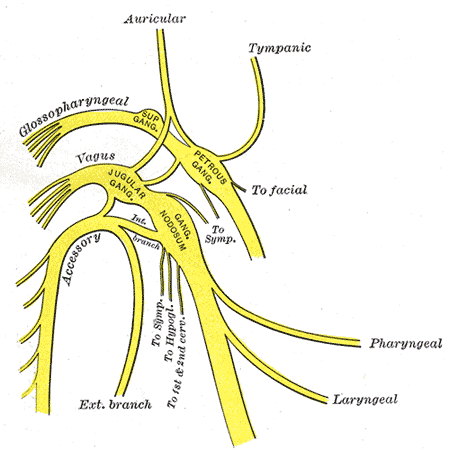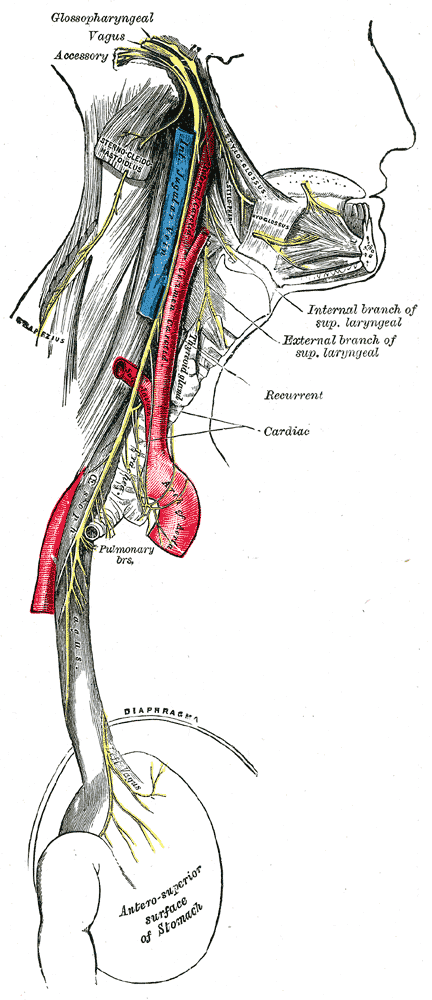Have you ever heard of the vagus nerve? Most people haven’t. However, you might want to learn about this important nerve. If you can properly do a little vagus nerve stimulation, you will find that you feel much better most days. There are multiple non-invasive vagus nerve stimulation options available. And the best part is you can easily do vagus nerve stimulation at home.

What is the Vagus Nerve?
The vagus nerve is the tenth cranial nerve. It is one of twelve cranial nerves that go from your brain through the rest of your body. This nerve is a pair of nerves, despite most people thinking it is a single nerve. You will find these nerves on both the right and left side of the brain stem near the medulla oblongata area. It is the longest of all the cranial nerves, because it goes from the brain stem to the colon.
The vagus nerve focuses on both motor and sensory functions. Without this nerve, you wouldn’t be able to feel sensations on your skin or within your muscles. You also wouldn’t be able to feel certain sensations in many of your organs.
As for the motor functions, the vagus nerve is responsible for the muscles in the larynx, pharynx, and soft palate. It also helps lower your resting heart rate and creates contractions to move foods throughout your body.
Problems Related to the Vagus Nerve
It can be easy for the vagus nerve to become damaged over time. Unfortunately, it can take some time to determine whether or not the vagus nerve is the cause of so many health issues. It is often not the first thing doctors think about when looking for a cause of a diagnosis.
The most common vagus nerve problem is actual nerve damage. When your vagus nerve is damaged, you may find yourself unable to speak or your voice may be hoarse. Other issues include:
- Loss of your gag reflex
- Unusual heart rate
- Pain in one or both ears
- Abnormal blood pressure
- Trouble drinking liquids
- Nausea
- Vomiting
- Abdominal bloating and abdominal pain
Vasovagal syncope and gastroparesis are two other health issues that are often caused by a damaged vagus nerve. Vasovagal syncope occurs when the vagus nerve overreacts. A sudden drop in blood pressure and heart rate will lead to fainting.
Gastroparesis is what happens when the stomach does not empty properly. Severe stomach pain, unexplained weight loss, and loss of appetite are a few of the symptoms of this health issue.
Vagus Nerve Stimulation

Thankfully, there is a way you can keep your vagus nerve healthy and working properly. Vagus nerve stimulation will keep this nerve working correctly, so you never show signs of nerve damage and the related health issues.
When people think about vagus nerve stimulation, they automatically think about a device placed inside the body to stimulate the nerve. While this is a helpful option for keeping your vagus nerve stimulated, you might want to consider a few non-invasive vagus nerve stimulation options before having a device implanted underneath your skin.
Vagus Nerve Stimulation Through Breathing
Diaphragmatic breathing is one of the best options for vagus nerve stimulation at home. This non-invasive vagus nerve stimulation option will instantly stimulate your vagus nerve. At the same time, you will notice your stress levels decrease.
Learning how to do diaphragmatic breathing is simple. When you go to breathe, you must make sure you are using your stomach, abdominal muscles, and diaphragm. This will ensure your lungs fill up completely with every breath you take.
Lungs that are consistently being completely filled with oxygen will always work more efficiently.
While it is helpful to always practice diaphragmatic breathing, you should at least do it between three and four times a day. Each session should be between five and ten minutes if you want to achieve the best results.
Other Non-Invasive Vagus Nerve Stimulation Options
Once you have the breathing exercises down for vagus nerve stimulation, you may want to add a few other stimulation options into your routine. When you are looking to stimulate your vagus nerve at home, you can easily do so with an exercise like yoga and singing.
Massage is an excellent way to stimulate this nerve and many other nerves throughout your body. Taking omega-3 supplements and intermittent fasting can also be helpful in some cases when the vagus nerve has become slightly damaged.
Benefits of Vagus Nerve Stimulation
There are so many benefits when it comes to stimulating your vagus nerve. The main benefits include relaxing your body, as well as your mind. However, we are sure you will love all the other benefits of vagus nerve stimulation too!
When you take the time to do vagus nerve stimulation at home, you will find your inflammatory response throughout your body is reduced. Your mood will improve, while your depression and anxiety lessen.
All of this is accomplished from a better immunity response, as well as a higher level of endorphins. Add in the new cells that your brain emits, and you will wonder why you didn’t pay closer attention to your vagus nerve much sooner!
Are you ready to stimulate your vagus nerve naturally? You will be amazed at how much better you feel once you start paying attention to this nerve you once knew nothing about.
There are so many options for vagus nerve stimulation. While you can choose the medical route and have a device implanted, we recommend trying a few non-invasive vagus nerve stimulation options first. There are so many possibilities for doing vagus nerve stimulation at home. So, you can easily stimulate this nerve without worrying about venturing out and spending tons of your valuable time on this one thing. If you choose the breathing exercises, you can do them wherever you are throughout the day and won’t even need to add anything more to your current schedule.
To learn more about how to stimulate the vagus nerve with breathing and all the diaphragmatic breathing benefits, we wrote a book, “Perfect Breathing.” This book has everything you need to know about better breathing for anxiety and so much more.



